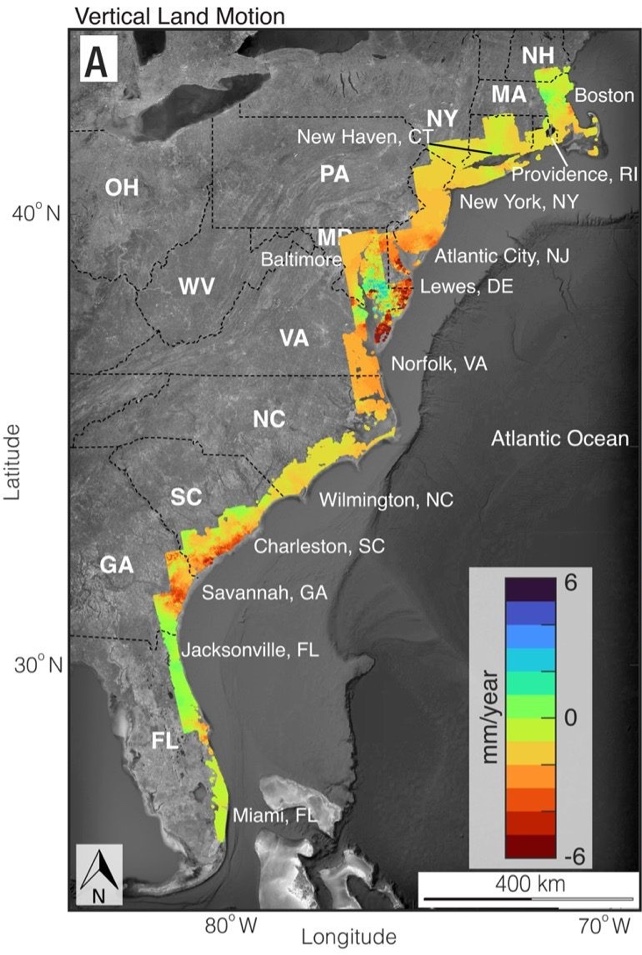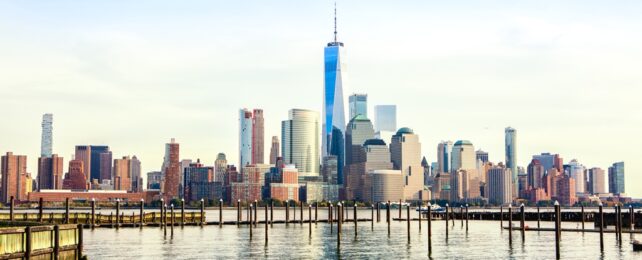Based on satellite imagery, geologists have determined major cities on the U.S. Atlantic coast are sinking, some areas as much as 2 to 5 millimeters (.08-0.2 inches) per year.
Called subsidence, this sinking of land is happening at a faster rate than was estimated just a year ago.
In a new paper published in the Proceedings of the National Academies of Sciences, researchers say their analysis has far-reaching implications for community and infrastructure resilience planning, particularly for roadways, airport runways, building foundations, rail lines, and pipelines.
These coastal areas, which include population centers such as New York City, Baltimore, Virginia Beach and Norfolk, are also vulnerable to weather and storm issues. The land subsidence problem exacerbates any problems caused by increasingly intense storms due to climate change.

"Continuous unmitigated subsidence on the U.S. East Coast should cause concern," said lead author Leonard Ohenhen, a graduate student working with Associate Professor Manoochehr Shirzaei at Virginia Tech's Earth Observation and Innovation Lab, in a press release from Virginia Tech.
"This is particularly in areas with a high population and property density and a historical complacency toward infrastructure maintenance."
The research team, from Virginia Tech and the U.S. Geological Survey, used satellite imagery and radar data to create digital terrain maps that show exactly where the land subsidence presents the most risks to vital infrastructure.
They used data from multiple years, which showed a large area of the East Coast is sinking at least 2 mm (.08 inches) per year, with several areas along the mid-Atlantic coast — up to 3,700 square kilometers, or more than 1,400 square miles — is sinking more than 5 mm (0.2 inches) per year.
Adding complexity to the issue is that the current rate of global sea level rise is estimated to be about 4 mm per year.
"We measured subsidence rates of 2 mm per year affecting more than 2 million people and 800,000 properties on the East Coast," Shirzaei said.
"We know to some extent that the land is sinking. Through this study, we highlight that sinking of the land is not an intangible threat. It affects you and I and everyone, it may be gradual, but the impacts are real."
In their paper, "Slowly but surely: Exposure of communities and infrastructure to subsidence on the US east coast," the team wrote that they evaluated the subsidence-hazard exposure to population, assets, and infrastructure systems/facilities along the US east coast:
"Here, we show that 2,000 to 74,000 square km land area, 1.2 to 14 million people, 476,000 to 6.3 million properties, and greater than 50% of infrastructures in major cities … are exposed to [these] subsidence rates."
"Here, the problem is not just that the land is sinking. The problem is that the hotspots of sinking land intersect directly with population and infrastructure hubs," said Ohenhen.
"For example, significant areas of critical infrastructure in New York, including JFK and LaGuardia airports and its runways, along with the railway systems, are affected by subsidence rates exceeding 2 mm per year. The effects of these right now and into the future are potential damage to infrastructure and increased flood risks."
"This information is needed. No one else is providing it," said Patrick Barnard, a research geologist with the USGS and co-author of the study. "Shirzaei and his Virginia Tech team stepped into that niche with his technical expertise and is providing something extremely valuable."
This article was originally published by Universe Today. Read the original article.
